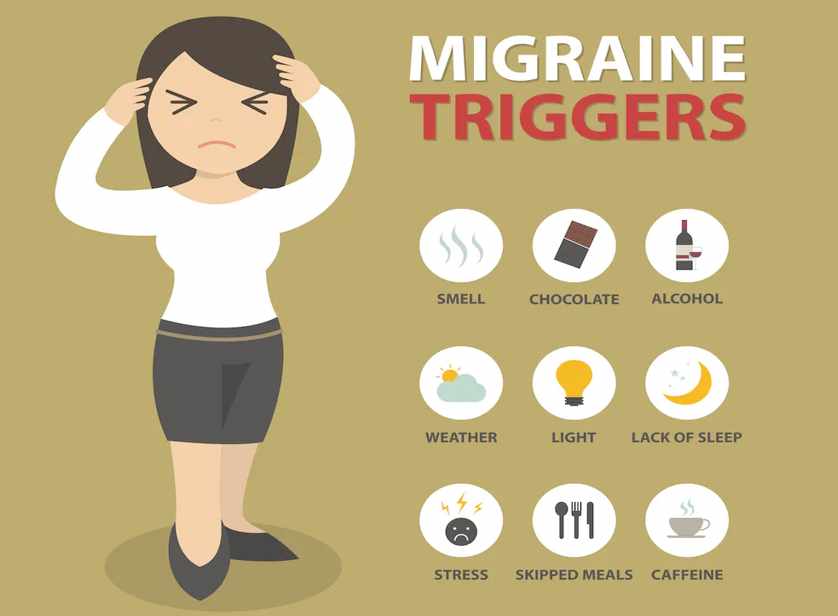
What Is A Migraine?
Migraine is a genetic disorder characterized by recurrent headache attacks that vary in intensity, frequency, and duration. Migraine is specific to each person. Migraine headaches are triggered by unusual physical activity or any movement. Blood flow in the brain and surrounding tissues are affected by the changes. Migraine pain is most commonly experienced in the forehead. It usually affects one side of the head, but it can affect both sides or shift. It is widely accepted that chemical compounds and hormones such as serotonin and oestrogen frequently play a role in migraine sufferers’ pain sensitivity. According to one aspect of the theory of migraine pain, migraine pain occurs because of waves of activity by groups of excitable brain cells. Serotonin is a chemical that is required for nerve cell communication.
Aura is a collection of sensory, motor, and verbal symptoms that typically act as early warning signs of the onset of a migraine headache. It typically occurs prior to headache pain, though it occasionally happens during or even after. Reversible means that the effects of an aura can be stopped or reversed. Having confusing thoughts or feelings, blank spots or blind regions in the field of vision, and difficulties communicating are all symptoms of the aura.
Types Of Migraine

Migraine with aura: Migraine with aura in this scenario, symptoms appear before actual discomfort in the brain region. This migration affects approximately 15–20% of the population. A migraine with aura is characterized by weakness in the shoulders, neck, or limbs.
Migraine without aura (common migraine): This type of migraine headache occurs without the appearance of an aura. The symptoms are the same for both types of migraine, but the aura phase does not occur in this case. Most of the time, a person has no sensory problems prior to an episode.
Migraine without headache: Silent migraine, also known as acephalgic migraine, involves aura signs but not the characteristic headache that follows.
Migraine with hemiplegia: Hemiplegia is a type of paralysis that causes numbness on one side of the body. It is characterized by transient paralysis (hemiplegia) or neurological or sensory abnormalities on one side of the body. This migraine could cause transient numbness and significant weakness on one side of your body. It is not necessary to feel discomfort in the head region with this migraine.
Retinal migraine (ocular migraine): A migraine or pain that occurs around the eye in the ocular region This migraine impairs your vision. It includes some pain behind the eye and may move to the brain. This type of migraine has a significant impact on eyesight, so we should consult a doctor if it is severe. This type of retinal migraine reduces ocular effectiveness.
Chronic migraine: It arises when a migraine occurs for at least 15 days per month. The severity and frequency of chronic migraine symptoms can vary. Chronic migraine is associated with increased impairment and a significant impact on physical, social, and occupational life. Chronic migraine patients have a lower quality of life and poorer health than other categories of migraine patients. People who suffer from chronic migraine are more dependent on drugs. Medication overuse headaches affect nearly two-thirds of chronic migraine sufferers. This is a side effect of routinely taking medications for relief. There is no cure, but we can lessen the symptoms, which helps us feel better.
Migraine with brainstem aura: This migraine includes symptoms associated with the brainstem, which is located on the backside of the skull and is the starting place of the spinal cord. Slurred speech, loss of balance, and vomiting are common symptoms. It occasionally includes back pain. It is also referred to as a basilar migraine. The earliest symptoms of this are known as brainstem aura-type migraines.
Status migraine: It is an uncommon and severe type of migraine that can continue for up to 72 hours. The headache, discomfort, and nausea might be intense. This form of migraine can be caused by drug withdrawal. Status migraine is characterized by uncontrollable migraine attacks that are difficult to manage. The reason for the attacks is unknown.
Signs And Symptoms
Migraine symptoms include:
- Being light-sensitive.
- Hunger.
- Food cravings.
- Lack of appetite Fatigue.
- Mood swings.
- Extreme thirst.
- Constipation Bloating.
- Unable to speak clearly.
- Feeling heavy in the arms and legs.
- Fatigue and muscle aches.
- Stiffness in the neck.
- Exposure to light and sound.
Causes
- Changes in the brainstem and its interactions with the trigeminal nerve, a significant pain channel, could play a role. Unbalances in brain chemicals, such as serotonin, which helps regulate pain in your neurological system, could also play a role. Serotonin’s involvement in migraines is being investigated by researchers. Other neurotransmitters, such as calcitonin gene-related peptides (CGRP), play a role in migraine pain.
Risk Factor
Family history: If you have a family member who suffers from migraines, you are more likely to develop them as well. The most powerful and consistent risk factor for migraine is a family history of migraine. However, there has been little systematic research on the reliability of family history information in detecting migraine based on valid diagnostic interviews.
Age: Migraines can start at any age, but they most commonly start during adolescence. Migraines tend to peak in your 30s and then gradually become less severe and less frequent over the next few decades.
Sex: Women are three times more likely than men to suffer from migraines. Changes in hormone levels Migraine sufferers may experience headaches just before or shortly after menstruation.
Hormonal changes: For women who suffer from migraines, headaches may begin just before and shortly after menstruation begins. They may also undergo changes during pregnancy or menopause. Migraines are more common after menopause.
Migraine Triggers

There are numerous migraine triggers:-
Sensory stimulation: Bright or flashing lights, as well as loud sounds, can cause migraines. Some people experience migraines when they are exposed to strong odours such as perfume, paint thinner, second-hand smoke, and others.
Changes in hormones Estrogen fluctuations: hormones such as serotonin, which are important for mood swings and inner happiness, most changes in oestrogen hormone levels occur during and before the menstrual month. Changes in oestrogen hormone levels during and before the menstrual period are the most common causes of migraine in women. Many women’s contraception is causing their migraines to intensify.
Stress: The most prevalent cause of migraine and accompanying pain is stress. Today’s way of life is unhealthy and stressful. Work stress, life stress, deadline stress, and a variety of other factors all have an impact on people’s physical and mental health.
Drinks: overuse of caffeinated beverages such as coffee and wine exacerbate the migraine effect.
Changes in sleep: Migraine is caused by a lack of sleep and a shift in the circadian cycle. Sleep schedule changes cause more migraines.
Foods: Processed foods, salty foods, and unhealthy cheese all increase the impact of migraine.
- Medication: The overuse of drugs like NSAID cause migraine.
Are Migraines Fatal?
- Most migraines are harmless. Migraine infarction is a rare complication. That’s when you have a stroke while suffering from a migraine. However, there is no evidence that a migraine can cause a stroke. A hemiplegic migraine is extremely rare, but it can occasionally result in a coma or other serious complications. A severe headache that appears out of nowhere can be a sign of a more serious condition, such as a stroke or aneurysm. If this happens, seek medical attention immediately. It is necessary to notify a physician to avoid a severe condition.
Treatments

OTC: OTC medications are frequently utilized. Many of them are NSAIDs, such as ibuprofen or aspirin. These drugs aid patients suffering from mild to moderate migraine pain. It provides immediate pain relief. Some medications are employed, such as diclofenac, acetaminophen, and naproxen.
Antihypertensive: These medications are used to treat excessive blood pressure and can also aid with migraine symptoms. Antihypertensive medicines such as beta-blockers (candesartan) are used to prevent migraines. Beta-blockers cause the heart to beat more slowly and forcefully, resulting in lower blood pressure. Beta-blockers also help to widen veins and arteries, increasing blood flow. Certain anticonvulsant drugs may also be able to prevent migraines. These medications act on multiple brain targets.
Antidepressants: Some antidepressants, such as amitriptyline and venlafaxine, may be able to prevent migraine attacks. Antidepressants help boost neurotransmitters. These substances in the brain include serotonin and adrenaline. They can boost mood and emotion, though the method is not entirely understood. Increased neurotransmitter levels can also interfere with pain signals delivered by the nerves.
Ca channel blockers include: Calcium channel blockers are also being studied because they may help in delaying or preventing disorders that will be more severe if high blood pressure is present earlier in life. These drugs can lower blood pressure, avoid cardiac rhythm issues, and more by slowing down how your cells use calcium. Calcium channel blockers have a major impact on migraine and cluster headache prevention. Verapamil and flunarizine, particularly in women of reproductive age.
Antiemetics: Antiemetics are useful for reducing those symptoms, but they can also be beneficial for people who get migraines without those symptoms. The most secure migraine treatment for expectant mothers and their developing children is typically thought to be an antiemetic. According to certain data, metoclopramide, an antiemetic, is the most frequently given migraine drug for pregnant patients receiving hospital care. To minimize nausea, antiemetics such as chlorpromazine and prochlorperazine are routinely used in combination with NSAIDs.
Triptans: Triptans mimic the action of serotonin, a brain neurotransmitter. Overactive pain nerves are calmed as a result. The alterations in your brain that led to your migraine are therefore reversed by triptans. When taken shortly after the onset of your headache and while your pain is still minimal, all triptans perform best. Triptans function by clinging to specific serotonin receptors in your brain, which are chemical binding sites. They are believed to lessen the swelling of blood vessels that causes pain when they interact with these receptors. They might also interfere with the nerve signals that cause pain.
These are the first-line treatments for migraine symptoms ranging from mild to severe. These medications, such as sumatriptan, eletriptan, and rizatriptan, are typically the first line of defense for migraine sufferers who have nerve pain as a symptom of their attacks.
Other Treatments:
1) A person’s life and way of life have a significant impact on their health. To be healthy, mental and social well-being is just as crucial as physical strength. Better sleeping habits, such as sleeping for the recommended amount of time and going to bed at the same time every night, Better eating practices, such as not skipping meals and avoiding your food triggers, and Stress management If you are obese, you should lose weight. Your doctor can recommend medication if you suffer from frequent migraines in order to lessen the frequency of episodes.
2) Regular Exercise: Exercise and stretching promote a healthy lifestyle. Regular exercise helps to keep our bodies fit and healthy. It is beneficial to migraine sufferers. Recent studies have demonstrated that a variety of bodily molecules change in response to exercise. Researchers studying headaches are now discovering evidence that suggests that, for some people, moderate exercise can lessen the frequency and intensity of migraine attacks. They discovered that routine exercise can help avoid migraines.
3) Relaxation: Relaxation is essential after a stressful day at work. Relaxation benefits both physical and mental health. Preventing triggers increases the odds of reduced migration. Here are a few techniques for unwinding. But first, make sure you are in a peaceful area that is uncluttered, as well as in a position that is comfortable for you. Try to ignore worry and other distractions, as challenging as that may sound. You must become familiar with your own breathing patterns and alter them in ways that will help you relax if you want to learn how to relax and manage headaches and migraines.
4) Yoga: Yoga is the practice of finding serenity and relaxing in order to energize our minds and body. Yoga is the finest stress relief. Yoga can relieve stress, calm the mind and body, and improve overall health.
Meditation

- Many migraine sufferers seek alternative remedies that may provide relief or prevention without the need for drugs. Meditation may block the component of the neurological system responsible for stress. Mediation as a technique for stress reduction may increase stress awareness and management. Stress, tension, and worry can all cause or worsen migraine attacks, and mind-body therapies like meditation can help relieve migraines by reducing underlying stress.
Yoga
- Yoga for migraine: Yoga may be an effective strategy to lessen the frequency and intensity of migraine headaches. Yoga can help decrease blood pressure and hypertension. It slows the body’s recovery from stressful events such as migraine attacks. Many studies indicate that yoga can be used as an adjunct therapy to treat migraines and migraine-related impairments. There are several yoga poses for migraine relief listed below. But use caution, as not all of these techniques are free from negative effects. By using some of these strategies, you run the risk of developing conditions like hypotension, heart attacks, sleeplessness, and nausea, to mention a few.
1. Savasana:-

- When you have a migraine and all you want to do is lay still in a dark room, Corpse Pose can help you relax into a meditative state, or at the very least, allow your mind to rest and find relief from the pain.
2. Bridge Pose:-

- Bridge pose relieves tension in the upper body. By raising your heart above your head in this pose, you increase the blood supply to your brain.
3. Uttasan:-

- Moving Forward Bending relieves stress and improves circulation, which can aid in hormone regulation.
4. Adhomukhasan:-

- Increases blood flow to the head, which can often be just what you need to relieve a headache and leave you feeling energised.
5. Pose Of A Happy Baby:-

- This soothing post will make you feel better. If your headache is caused by back pain that is radiating up your spine, or if you simply need to relax for a few minutes, try the Happy Baby Pose. So, is there a natural method to treat migraines that don’t harm the body? Yoga is that. Through a combination of physical postures and breathing techniques, yoga is an age-old practice that encourages holistic living. The side-effect-free treatment for migraines is yoga.
Top 13 Interesting Facts Of Migraine
Migraine can induce discomfort in any part of the head.
Migraine symptoms extend beyond pain.
If your migraine lasts more than three days, there may be something more going on.
Migraines affect children as well as adults.
Keeping a headache diary can assist with migraines.
Migraine affects more women than men.
Migraine can be activated from within the brain.
52% of persons with migraine disease go undetected by a doctor.
Women account for 70% of migraine patients.
It is estimated that the industry loses $31 billion per year owing to unavailability, lost productivity, and medical expenses caused by migraine.
Migraines are linked to menstruation.
Migraines can occur without causing a headache.
You can detect migraines.






